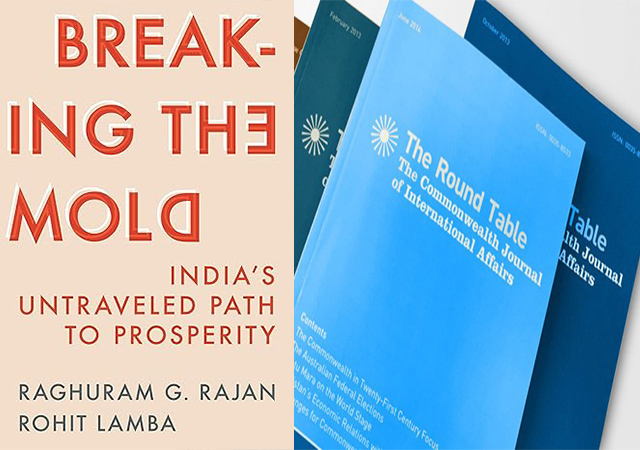
[This is an excerpt from an article in The Round Table: The Commonwealth Journal of International Affairs and Policy Studies.]
Breaking the Mold (‘Mould’ in the King’s English) is an unusual book. The strapline beneath the main title is ‘India’s Untraveled Path to Prosperity’ and the book is essentially a basic lesson in economics and economic policy. Happily, it caters to the lay reader and is shorn of the technical jargon with which most economics textbooks are replete – except for the reference to the ‘smile curve’, an economic model that illustrates how value-added varies across different stages of the value chain in an industry. However, there is an unmistakeable dose of politics permeating the book, which often takes aim at the policies of the Modi administration in India, elements of which the authors argue to be inimical to the rapid and inclusive growth that India needs and can achieve. Many pages are devoted to governance, institutions and structures, and even foreign policy, and how these can impact on development. Indeed, some may be inclined to think that the timing of the book’s release, on the eve of the 2024 General Election in India, was no coincidence. That election, of course, saw the ruling Bharatiya Janata Party (BJP) lose its majority in Parliament and having to cobble together coalition arrangements with two other regional parties to get over the line.
Raghuram Rajan has a strong pedigree as an economist. Serving as Governor of the Reserve Bank of India (RBI, the country’s central bank) from 2013 to 2016 has arguably been the brightest feather in his cap and qualifies him eminently to write this book. He was appointed to that position by the Congress-led Government of Prime Minister Manmohan Singh and continued to serve in it two years into the first Modi Government. Earlier, he had served as Chief Economist at the International Monetary Fund from 2003 to 2007 and more recently was a member of the Bank of International Settlements. He is currently the Katherine Dusak Miller Distinguished Service Professor of Finance at the University of Chicago’s Booth School of Business. Rajan’s co-author, Rohit Lamba, is Assistant Professor of Economics at Pennsylvania State University and has also worked in the Office of the Chief Economic Adviser to the Government of India; the publication of this book with Rajan would have given Lamba’s profile a considerable boost.
The book focuses on the state of the Indian economy and on the two sides of the polarised debate on that subject – one relentlessly bullish and the other much more critical. While acknowledging India’s achievements, the authors offer stark reminders throughout the book of how India’s growth to becoming the fourth largest economy in the world, overtaking the United Kingdom, has generated a large measure of hype and how far the country must still travel and how it is still constrained by various factors that prevent proper take-off.
The comparison with China features prominently. The book contends that China started modernising its economy a decade before India and grew at a much brisker pace, leaving India far behind. While China followed the standard development model – starting with agriculture, moving to low-skilled and then high-skilled manufacturing, and finally to services – India has been compelled to fast-track its approach, but is still lagging behind. The Indian economy is still only one-fifth the size of China’s and India’s per capita income is projected to reach US$ 10,000 by 2060, a figure lower than what China has already achieved.
Research Article – India’s place in America’s world under the Biden presidency: Decoding the China factor
India–China relations – the present, the challenges and the future
The authors contend that India’s growth is too slow to provide jobs for millions of its ambitious youth. They point out a number of deficiencies in its effort to record socio-economic development. These include huge unemployment and disguised unemployment, very low percentage of female labour force, inadequate opportunities for vocational training, a mushrooming of educational institutions leading to a drop in quality, and inadequate emphasis on and investment in both quality education and healthcare. The country’s ‘majoritarian authoritarianism’ in politics is also seen as a major obstacle. Rajan and Lamba would like to see India accelerate growth by prioritising human capital, expanding opportunities in high-skilled services, encouraging entrepreneurship and strengthening, rather than weakening, its democratic tradition.
A key message emerging from the book is that India should stop obsessing itself with manufacturing – a bus that left the station a long time ago and one that India missed. Instead, the country should aim to garner a larger portion of the global value chain in services. It is already doing well in the IT sector and in chip design. But much more needs to be done by way of creating the enabling environment, including greater investment in education, reforming labour laws and making it easier for businesses to get off the ground.
Amitav Banerji is a member of the Round Table editorial board.
Breaking the mold by Raghuram G Rajan and Rohit Lamba, Princeton University Press, 2024.
Related articles:
Commonwealth Round Table Bookshelf
Recent Round Table Book Reviews



